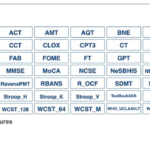
Available Measures
Our database contains the most commonly used measures in the field of neuropsychology, and we welcome any suggestions on additions. More than 70 measures with studies from published journals are available for scoring, including all trials associated with each measure. Measure categories include Attention and Concentration, Visual and Verbal Learning, Cognitive Battery, Decision Making, and many others. We welcome the addition of new measures and will provide an easy method to include them into our database.
- [5_Digit_Stroop] Five-Digit Stroop Test
- [9HolePeg] Nine-Hole Peg
- [ACE_R] Addenbrooke’s Cognitive Examination Revised
- [ACT] Auditory Consonant Trigrams
- [AMT] Australia Motor Test
- [AQT] Alzheimer’s Quick Test
- [BDAE_CIM] BDAE Complex Ideational Material
- [BDI_PC] Beck Depression Inventory (Primary Care)
- [BNE] Batería Neuropsicológica en Español
- [BNT] Boston Naming Test
- [BNT15] Boston Naming Test-15 item
- [BVMT_R] Brief Visuospatial Memory Test Revised
- [BVRT] Benton Visual Retention Test
- [CAN] Cancellation Tests
- [CCPT_II] Conners Continuous Performance Test-II
- [CCT] Children’s Category Test
- [CLOX] CLOX
- [CPT3] Conners CPT3
- [CT] Category Test
- [CTT] Color Trails Test
- [DFT] Design Fluency Test
- [DigitSpan] Digit Span
- [DigSym] Coding (Digit Symbol)
- [DYNA] Grip Strength Test
- [EIWA] Escala de Inteligencia Wechsler para Adultos
- [FAB] Frontal Assessment Battery
- [FOME] Fuld Object-Memory Evaluation
- [FT] Finger Tapping Test
- [GPT] Grooved Pegboard Test
- [HDS] HIV Dementia Scale
- [HVLT] Hopkins Verbal Learning Test
- [HVOT] Hooper Visual Organization Test
- [IGT] Iowa Gambling Task
- [JLO] Judgement of Line Orientation
- [MDRS] Mattis Dementia Rating Scale
- [MMSE] Mini-Mental Status Exam
- [MoCA] Montreal Cognitive Assessment
- [NCSE] Cognistat
- [NeSBHIS] Neuropsychological Screening Battery for Hispanics
- [NEUROPSI1] Evaluación Neuropsicológica Breve en Español
- [NEUROPSI_1] NEUROPSI
- [NIHToolboxCog] NIH Toolbox Cognition Battery
- [OTT] Orals Trails Test
- [PASAT] Paced Auditory Serial Addition Test
- [PerriAVLT] Perri Auditory Verbal Learning Test
- [RavensPMT] Raven’s Progressive Matrices Test
- [RBANS] Repeatable Battery for the Assessment of Neuropsychological Status
- [R_OCF] Rey-Osterrieth Complex Figure
- [SDMT] Symbol Digit Modality Test
- [SemiCF] Semicomplex Figure
- [SPM] Raven’s Standard Progressive Matrices
- [SPNP11LA] Spanish-Language NP Tests in Eleven Latin American Countries
- [SPNP9LA_Peds] Spanish-Language NP Test in 9 Latin American Countries-Peds
- [Stroop_C] Comalli Stroop
- [Stroop_G] Golden Stroop
- [Stroop_H] Hammes Stroop
- [Stroop_K] Kaplan Stroop
- [Stroop_V] Stroop Victoria
- [TexMexAANS] TexMexAANS
- [TMT] Trailmaking Test
- [TPT] Tactual Performance Test
- [VF] Verbal Fluency Test
- [VFDT] Visual Form Discrimination Test
- [VSVT] VSVT
- [WAIS_IV_Mexico_] WAIS-IV (Mexico)
- [WCST_128] Wisconsin Card Sorting Test-128
- [WCST_64] Wisconsin Card Sorting Test-64 Card
- [WCST_M] Wisconsin Card Sorting Test-Modified Version
- [WHO_UCLAAVLT] WHO/UCLA AVLT
- [WRMT_Words] Warrington Recognition Memory Test–Words
In addition to normative data added by the NeuroPsychNorms team to the database, you are more than welcome to suggest studies containing new uncollected data or even measures for which we do not have any data at all.
While our literature tended to focus on normative data and/or control subjects on an experimental trial, the database also includes abnormal data (e.g., TBI, dementia, stroke) and unique data (e.g., re-test data and under other unique conditions). Again, feel free to suggest new studies with abnorms and unique conditions to an existing measure.
The database is configured so you can sort the data easily by the N-size, Demographics or Year. Number of Demographic Stratifications is determined by the number of Stratification types that the study separates their data based on demographic information. For example, if the data of a study is separated by Age, Education, and Gender Identity, this will be at a higher rank than a 2-tier stratification (Age and Education).